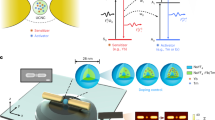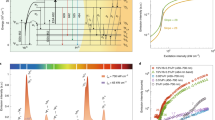Abstract
Superfluorescence (SF) is a unique quantum optics phenomenon arising from the assembly of self-organized and cooperatively coupled emitters. SF produces a short and intense burst of light, ideal for various applications in nanophotonics and optical computing. However, due to the prerequisite for cooperative emitter coupling, SF was conventionally observed in a Stokes-shifted manner under cryogenic conditions in limited systems (for example, atomic gases and perovskite-nanocrystal superlattices). Here we show that room-temperature anti-Stokes-shift SF is achieved in a few randomly assembled or in a single lanthanide-doped upconversion nanoparticle. Moreover, upconverted SF has a 10,000-fold accelerated nanosecond lifetime (τ = 46 ns of SF versus τ = 455.8 μs for normal upconversion luminescence), overcoming the slow decay of conventional upconversion systems. Therefore, the conceptual room-temperature anti-Stokes-shift SF not only lays the foundation for ultrafast upconversion but it also paves a straightforward way to a wide variety of applications that have been limited by the existing SF system.
This is a preview of subscription content, access via your institution
Access options
Access Nature and 54 other Nature Portfolio journals
Get Nature+, our best-value online-access subscription
$29.99 / 30 days
cancel any time
Subscribe to this journal
Receive 12 print issues and online access
$209.00 per year
only $17.42 per issue
Buy this article
- Purchase on Springer Link
- Instant access to full article PDF
Prices may be subject to local taxes which are calculated during checkout




Similar content being viewed by others
Data availability
All data relating to the paper are provided in the Supplementary Information. Source data are provided with this paper.
References
Altug, H., Englund, D. & Vučković, J. Ultrafast photonic crystal nanocavity laser. Nat. Phys. 2, 484–488 (2006).
Lu, Y.-J. et al. Plasmonic nanolaser using epitaxially grown silver film. Science 337, 450–453 (2012).
Gourley, P. L. Nanolasers. Sci. Am. 278, 56–61 (1998).
Dicke, R. H. Coherence in spontaneous radiation processes. Phys. Rev. 93, 99–110 (1954).
Bonifacio, R. & Lugiato, L. A. Cooperative radiation processes in two-level systems: superfluorescence. II. Phys. Rev. A 12, 587–598 (1975).
Skribanowitz, N., Herman, I. P., MacGillivray, J. C. & Feld, M. S. Observation of Dicke superradiance in optically pumped HF gas. Phys. Rev. Lett. 30, 309–312 (1973).
Gibbs, H. M., Vrehen, Q. H. F. & Hikspoors, H. M. J. Single-pulse superfluorescence in cesium. Phys. Rev. Lett. 39, 547–550 (1977).
Florian, R., Schwan, L. O. & Schmid, D. Superradiance and high-gain mirrorless laser activity of O−2-centers in KCl. Solid State Commun. 42, 55–57 (1982).
Malcuit, M. S., Maki, J. J., Simkin, D. J., Boyd & Robert, W. Transition from superfluorescence to amplified spontaneous emission. Phys. Rev. Lett. 59, 1189–1192 (1987).
Zinovev, P. V. et al. Superradiation in a diphenyl/pyrene crystal. Zh. Eksp. Teor. Fiz. 85, 1945–1952 (1983).
Dai, D. C. & Monkman, A. P. Observation of superfluorescence from a quantum ensemble of coherent excitons in a ZnTe crystal: evidence for spontaneous Bose-Einstein condensation of excitons. Phys. Rev. B 84, 115206 (2011).
Timothy Noe Ii, G. et al. Giant superfluorescent bursts from a semiconductor magneto-plasma. Nat. Phys. 8, 219–224 (2012).
Rainò, G. et al. Superfluorescence from lead halide perovskite quantum dot superlattices. Nature 563, 671–675 (2018).
Cherniukh, I. et al. Perovskite-type superlattices from lead halide perovskite nanocubes. Nature 593, 535–542 (2021).
Findik, G. et al. High-temperature superfluorescence in methyl ammonium lead iodide. Nat. Photon. 15, 676–680 (2021).
Wu, Y. et al. Upconversion superburst with sub-2 μs lifetime. Nat. Nanotechnol. 14, 1110–1115 (2019).
Shen, J. et al. Engineering the upconversion nanoparticle excitation wavelength: cascade sensitization of tri-doped upconversion colloidal nanoparticles at 800 nm. Adv. Opt. Mater. 1, 644–650 (2013).
Xie, X. et al. Mechanistic investigation of photon upconversion in Nd3+-sensitized core–shell nanoparticles. J. Am. Chem. Soc. 135, 12608–12611 (2013).
Lee, C. et al. Giant nonlinear optical responses from photon-avalanching nanoparticles. Nature 589, 230–235 (2021).
Wang, J. et al. Enhancing multiphoton upconversion through energy clustering at sublattice level. Nat. Mater. 13, 157–162 (2014).
Heinzen, D. J., Thomas, J. E. & Feld, M. S. Coherent ringing in superfluorescence. Phys. Rev. Lett. 54, 677–680 (1985).
Stokes, G. G. On the change of refrangibility of light. Phil. Trans. R. Soc. 142, 463–562 (1852).
Wei, Wei et al. Alleviating luminescence concentration quenching in upconversion nanoparticles through organic dye sensitization. J. Am. Chem. Soc. 138, 15130–15133 (2016).
Stokes, G. G. On the change of refrangibility of light. Phil. Trans. R. Soc. 142, 463–562 (1852).
Auzel, F. Upconversion and anti-Stokes processes with f and d ions in solids. Chem. Rev. 104, 139–173 (2004).
Wang, F. et al. Simultaneous phase and size control of upconversion nanocrystals through lanthanide doping. Nature 463, 1061–1065 (2010).
Wu, S. et al. Non-blinking and photostable upconverted luminescence from single lanthanide-doped nanocrystals. Proc. Natl Acad. Sci. USA 106, 10917–10921 (2009).
Hata, R., Yokoshi, N., Ajiki, H. & Ishihara, H. Up-conversion superfluorescence induced by abrupt truncation of coherent field and plasmonic nanocavity. J. Chem. Phys. 151, 224307 (2019).
Cong, K. et al. Superfluorescence from photoexcited semiconductor quantum wells: magnetic field, temperature, and excitation power dependence. Phys. Rev. B 91, 235448 (2015).
Roberts, J. E. Lanthanum and neodymium salts of trifluoroacetic acid. J. Am. Chem. Soc. 83, 1087–1088 (1963).
Acknowledgements
We acknowledge the Electron Microscopy Facility at the University of Massachusetts Chan Medical School for assistance on the transmission electron microscopy and SEM characterizations. This material is based on work supported, in part, by the US Army Research Laboratory and the US Army Research Office under W911NF2110283.
Author information
Authors and Affiliations
Contributions
S.F.L. and G.H. conceived the study., S.F.L., G.H., K.H. and K.K.G. wrote the manuscript. All the authors provided feedback and helped with the research, data analysis and manuscript preparation.
Corresponding authors
Ethics declarations
Competing interests
The authors declare no competing interests.
Peer review
Peer review information
Nature Photonics thanks the anonymous reviewers for their contribution to the peer review of this work.
Additional information
Publisher’s note Springer Nature remains neutral with regard to jurisdictional claims in published maps and institutional affiliations.
Supplementary information
Supplementary Information
Supplementary Figs. 1–12, Notes 1–3 and references.
Source data
Source Data Fig. 2
Statistical source data.
Source Data Fig. 3
Statistical source data.
Source Data Fig. 4
Statistical source data.
Rights and permissions
Springer Nature or its licensor holds exclusive rights to this article under a publishing agreement with the author(s) or other rightsholder(s); author self-archiving of the accepted manuscript version of this article is solely governed by the terms of such publishing agreement and applicable law.
About this article
Cite this article
Huang, K., Green, K.K., Huang, L. et al. Room-temperature upconverted superfluorescence. Nat. Photon. 16, 737–742 (2022). https://doi.org/10.1038/s41566-022-01060-5
Received:
Accepted:
Published:
Issue Date:
DOI: https://doi.org/10.1038/s41566-022-01060-5
This article is cited by
-
Proof of crystal-field-perturbation-enhanced luminescence of lanthanide-doped nanocrystals through interstitial H+ doping
Nature Communications (2023)
-
Structured air lasing of N2+
Communications Physics (2023)



